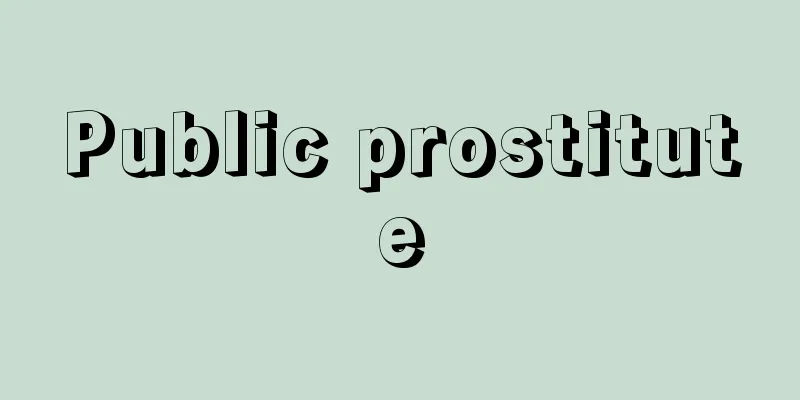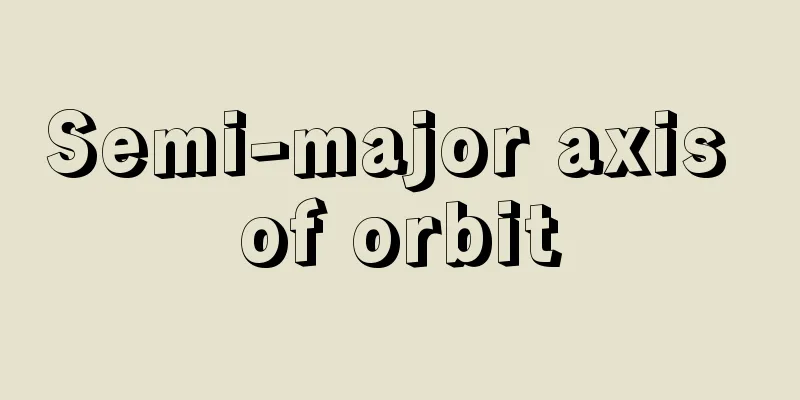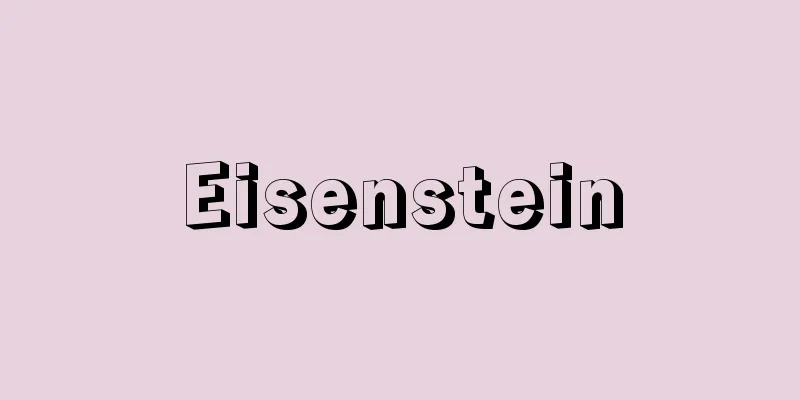Public prostitute

|
A general term for officially recognized prostitutes. The origin of prostitution is said to be the sexual acts between believers and shrine maidens in ancient temples, but since this has the nature of a religious rite, it is better not to consider it as officially recognized prostitution. So why did many societies in the past have licensed prostitutes? There are many reasons, including the extremely small number of women compared to the number of men gathering in cities, the fact that many men were forced to remain single because they were unable to meet the demands of a high dowry for marriage, the need for sexual release for military, caravan, and sailor groups of men only on holidays or in places of residence, and other reasons, prostitution was recognized as a necessary social evil and licensed prostitutes were established. Even for those in political power, the sexual dissatisfaction of the people often turned into dissatisfaction with politics, and it was easy to disturb public order, so they decided to officially recognize prostitution. However, in order to avoid disturbing social order too much, prostitution was often concentrated in specific designated areas. This is because it is convenient for the supervision of licensed prostitutes and also for cracking down on private prostitutes, and since the modern era when venereal diseases have spread, it is also convenient for testing for venereal diseases. However, it must be considered that this is a male-centered logic, and the social issues of the women who are sold into licensed prostitution, and the moral issues of the privileged people and businesses who make profits from women's prostitution, have been unfairly ignored for a long time. The history of public prostitution is quite long, and a public prostitution system was already in place in ancient Greece. It was founded by Solon of Athens. Cell-like huts for business were lined up in Piraeus, the port of Athens. The global trend of placing public prostitutes in certain areas on the outskirts of towns had already been in place since the Greek era. Since ancient Rome, public prostitutes were generally an important source of tax revenue, so they received a certain amount of protection from the establishment, while private prostitutes were subject to strict discipline in terms of public morals. For example, in ancient Rome, beggars (private prostitutes) were ordered to carry lanterns when walking around at night. Public prostitutes were also recognized in the Christian Middle Ages with the approval of landlords or churches. Popes Julius II, Leo X, and Clement VII also approved brothels. In the 16th century, approval came to be given by the state, state, city, or town, instead of the landlords and churches of the Middle Ages. Licensed prostitutes then began to exist all over the world, including in Europe and America. Then, with the development of capitalism, brothel management became corrupt and commercialized, which led to social issues such as human rights issues for poor women and the spread of sexually transmitted diseases, and finally a movement to abolish licensed prostitution arose in Europe. The goals of this movement included the abolition of official licenses for prostitutes by nations, states, cities, and towns, the dismantling of the prostitution environment based on congregated prostitution, and the prohibition of profiting from the use of licensed prostitutes. This movement became particularly widespread after World War II, and it is fair to say that the licensed prostitution system is now disappearing from almost all parts of the world. Next, looking at the history of the public prostitution system in Japan, the Azuma Kagami records that the Kamakura Shogunate appointed Yukun Betto (official bureaucrats), which is probably the oldest example of public prostitution. It is said that the Muromachi Shogunate also established the Keisei Bureau to collect taxes. However, it is safe to say that a full-scale public prostitution system was established with the approval of Keiseicho in Osaka by Toyotomi Hideyoshi in 1585 (Tensho 13). Soon, more than 20 brothels were established across the country, including in Kyoto, Osaka, and Sunpu. The Tokugawa Shogunate also recognized the establishment of a public prostitution system with designated areas of congregated prostitution, due in part to the fact that the number of men in Edo was overwhelmingly greater than the number of women. As the merchant class grew wealthy, Edo's Yoshiwara became a representative brothel in the country, along with Kyoto's Shimabara. After the Meiji period, there were the Meiji government's Emancipation Edict for Prostitutes, and in 1921 (Taisho 10), the Japanese government signed the League of Nations' conditions for banning the sale of women, with reservations. In reality, these measures were not implemented thoroughly, and licensed prostitution continued with tacit approval even into the Showa period. The abolition of this licensed prostitution system was postponed until after World War II, and was finally realized by order of the Supreme Commander for the Allied Powers (GHQ) in 1946 (Showa 21). The Anti-Prostitution Law came into effect 12 years later, in 1958. [Mitsusada Fukasaku] Source: Shogakukan Encyclopedia Nipponica About Encyclopedia Nipponica Information | Legend |
|
公認された娼婦の一般的呼称。売春の起源として、古代寺院で信徒と巫女(みこ)の間に行われた性行為があげられるが、これは宗教的秘儀の性格があるので、公認の売春とはみなさないほうがよい。では、なぜ、かつての多くの社会が公娼を置くようになったのか。理由はいろいろあるが、都市などに集まる男性の数に比べ極度に女性の数が少なかったり、結婚に高額の婚資を男性に要求する社会で、それができずに独身を余儀なくされている男性が多かったり、軍隊や隊商や船乗りなどの男性のみの集団に休日や寄留地で性的解放の必要があったり、その他さまざまな理由から売春を社会的必要悪と認め、公娼が置かれるようになった。政治的権力者にしても、民衆の性的不満が政治への不満に転じる場合がままあるし、治安を乱しやすいので、売春の公認に踏みきったわけである。ただし、社会秩序をあまり乱さないように、特定の指定地域で集娼制をとる場合が多かった。このようにすれば、公娼の監督に都合がよいし、私娼も取り締まることができ、また、性病が伝播(でんぱ)した近代以後は性病検査にも便利であるからである。ただし、これは男性本位の論理で、公娼に売られる女性側の社会問題や、女性に売春させ利益をあげる特権者や業者の道義的問題は、不当にも長い間顧みられなかったことを考慮しなければならない。 公娼の歴史はかなり古く、すでに古代ギリシアに公娼制度があった。創立者はアテナイ(アテネ)のソロン。アテナイの港ピレウスに営業用の独房式小屋が建ち並んでいた。公娼を置く一定の地域を町外れに決め置く世界的傾向は、すでにギリシア時代から行われていたわけである。古代ローマ以後は、一般に公娼は一つのだいじな税源なので、体制側から一種の保護を受け、私娼のほうは風紀上厳しく取締りを受けた。たとえば古代ローマでは、乞食(こじき)女(私娼)が夜歩きするときには提灯(ちょうちん)を持つ命令が出された。中世キリスト教時代にも公娼は領主や教会認可の形で認められた。教皇ユリウス2世、レオ10世、クレメンス7世なども淫売(いんばい)屋を認可した。16世紀に入ると、認可は、中世時代の領主や教会にかわって国家、州、市、町が与えることになる。そしてヨーロッパ、アメリカなど世界各地に公娼がいるようになった。 ついで資本主義の発達に伴い、淫売屋経営もあくどく商売化したために、貧しい婦女子の人権問題や、性病の広がりなどで社会問題となり、ようやくヨーロッパから公娼廃止運動がおこった。すなわち、国家、州、市、町による娼妓(しょうぎ)の公許の廃止、集娼的売春環境の解体、公娼に売春させることによって利益をあげる行為の禁止などが、この運動の目標とされた。第二次世界大戦後はとくにこうした運動が世界的になり、現在ではほとんど全世界から公娼制度は消滅しつつあるとみなしてよかろう。 次に日本の公娼制の歴史をみると、鎌倉幕府が遊君別当(ゆうくんべっとう)を置いた旨『吾妻鏡(あづまかがみ)』にあるが、これが公娼として最古の例証にあたろう。室町幕府も傾城(けいせい)局を設けて税を徴収したと伝えられる。しかし、本格的公娼制は豊臣(とよとみ)秀吉による1585年(天正13)の大坂傾城町の認可をもって、確立されたと考えてよかろう。そしてたちまち京都、大坂、駿府(すんぷ)など全国20余か所の遊廓(ゆうかく)が生まれた。徳川幕府も、女性に比べて男性の数が圧倒的に多い江戸という事情もあって、地域指定の集娼的公娼制を認めた。江戸・吉原(よしわら)は、商人階級の富裕化に伴い、京都の島原(しまばら)と並んで全国の遊廓の代表的存在となった。明治以降は、明治政府の娼妓解放令、1921年(大正10)の国際連盟の婦人売買禁止条件の日本政府による留保付き調印などがあった。これも現実的には徹底を欠き、昭和に入っても公娼は黙認の形で続いた。この公娼制の廃止は、第二次世界大戦後まで持ち越され、1946年(昭和21)の連合国最高司令部(GHQ)の指令で実現した。売春防止法はその12年後、58年に施行された。 [深作光貞] 出典 小学館 日本大百科全書(ニッポニカ)日本大百科全書(ニッポニカ)について 情報 | 凡例 |
Recommend
Twickenham
A district on the banks of the Thames in the west ...
Wako - Japanese pirates
It is a term found in Chinese and Korean document...
Differential thermal analysis
A general term for research methods and thermal an...
Family Farming - Kazoku no Ugyo Keiei
Agricultural management that uses family labor as...
Seal forgery crime
It is a crime to forge a seal or signature, to il...
SAS (synthetic detergent)
…(1) Dishwashing detergents must be safe, not dam...
Menthol - Mentooru (English spelling)
A representative monocyclic monoterpene alcohol. ...
Public enterprises - Public enterprises
〘 noun 〙 A company operated by a local government....
Miṣr (English spelling)
…The ancient Egyptians called their country Kemet...
Umbrian language - Umbriano (English spelling)
An extinct language belonging to the Italic branch...
Futon - Futon
A novella by Tayama Katai. Published in Shinshose...
Toleration Act
This law was enacted in England in May 1689, imme...
Overglaze paint - Uwaenogu
〘Noun〙 = Uwaegusuri (overglaze) Source: The Select...
Underground gasification of coal
This refers to the gasification of coal while it ...
《Hokubei Mainichi》(English spelling)HokubeiMainichi
...However, Japanese Americans continued their jo...


![Tatsuruhama [town] - Tatsuruhama](/upload/images/67cc22e8f133d.webp)






